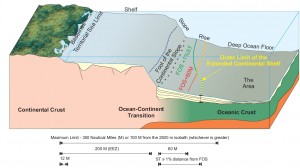
Under the United Nations Convention on the Law of the Sea (UNCLOS) the continental shelf is that part of the seabed over which a coastal State exercises sovereign rights with regard to the exploration and exploitation of natural resources including oil and gas deposits as well as other minerals and biological resources of the seabed. The legal continental shelf extends out to a distance of 200 nautical miles from its coast, or further if the shelf naturally extends beyond that limit.
Where the continental shelf extends beyond 200 nautical miles a State is required by UNCLOS (Article 76) to make a submission to the Commission on the Limits of the Continental Shelf (CLCS). This submission sets out the coordinates of the outer limits of the shelf and is accompanied by technical and scientific data to support the claim. The Commission assesses the limits and data submitted by the coastal State and makes recommendations.The outer limits of the continental shelf established by a coastal State based on these recommendations are final and binding.
Information on the CLCS, Article 76 of UNCLOS and the Executive Summaries of all submissions to the CLCS can be found at:
http://www.un.org/Depts/los/clcs_new/clcs_home.htm
